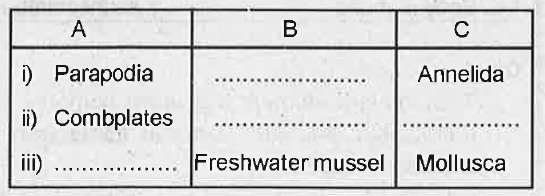In the anatomy lab. Eugin observed the following features in the T.S of a plant part.
a) Radial and polyarch xylem bundles
b) Parenchymatous (homogenous) cortex
c) Large pith
d) Epidermis with unicellular hairs
e) Pericycle
f) Endodermis with casparian strips.
i) Identify the plant part.
ii) Re-arrange the given regions from the periph-ery to the center in their correct sequence.
iii) Give an account of casparian strips.Solution in Malayalam
Step by step video solution for In the anatomy lab. Eugin observed the following features in the T.S of a plant part. a) Radial and polyarch xylem bundles b) Parenchymatous (homogenous) cortex c) Large pith d) Epidermis with unicellular hairs e) Pericycle f) Endodermis with casparian strips. i) Identify the plant part. ii) Re-arrange the given regions from the periph-ery to the center in their correct sequence. iii) Give an account of casparian strips. by Biology experts to help you in doubts & scoring excellent marks in Class 11 exams.
Updated on:21/07/2023Topper's Solved these Questions
Similar Questions
Fill in the blanks.

View Solutionselect the characters which are not applicable to the anatomy of dicot roots. (a) conjunctive tissue present (b) presnce of protein compounds in casparian strips © polyarch xylem bundles (d) presence of pericycle.
View SolutionWhat part of the plant would show the following ? (a) Radial vascular bundle (b) Polyarch xylem (c) Well develop pith
View SolutionSelect the characters which are not applicable to the anatomy of dicot roots. I. Conjunctive tissue present. II. Presence of protein compounds in casparian strips. III. Polyarch xylem bundles. IV. Presence of pericycle.
View SolutionWhich of the following characters are not applicable to the anatomy of dicot stem and choose the correct options given below?
I. Collenchymatous hypodermis.
II. Polyarch xylem.
III. The presence of casparian strips on the endodermis.
IV. Open vascular bundle.
V. The presence of medullary rays.
Select the correct answer using the codes given below
View SolutionMatch from the column given below :
Parts of Dicot RootsConsists of a.Epiblemai. Unicellular root hairb.Casparian strips ii. Vascular bundle and pithc.Pericycleiii.Waxy material suberin d.Steleiv.Thick walled parenchymatous cells.
View SolutionCasparian strips are present in the pericycle.
View SolutionCasparian strips of endodermis has deposition of
View SolutionWhat part of the plant would show the following ?
(a) Radial vascular bundle
(b) Polyarch xylem
(c) Well develop pith
View SolutionWhat part of the plant would show the following: (a) Radial vascular bundle (b) Polyarch xylem (c) Well developed pith
View SolutionWhat part of the plant would show the following:
Radial vascular bundle
polyarch xylem
Well developed pith
View SolutionIn the anatomy lab. Eugin observed the following features in the T.S of a plant part.
a) Radial and polyarch xylem bundles
b) Parenchymatous (homogenous) cortex
c) Large pith
d) Epidermis with unicellular hairs
e) Pericycle
f) Endodermis with casparian strips.
i) Identify the plant part.
ii) Re-arrange the given regions from the periph-ery to the center in their correct sequence.
iii) Give an account of casparian strips.
View SolutionWhich part of the plant would show the following ? (a) Radial vascular bundle (b) Polyarch xylem (c ) Well developed pith (d) Exarch xylem
View SolutionSelect the characters which are not applicable to the anatomy of dicot roots.
I. Conjunctive tissue present.
II. Presence of protein compounds in casparian strips.
III. Polyarch xylem bundles.
IV. Presence of pericycle.
View SolutionMatch from the column given below : {:("Parts of Dicot Roots","Consists of "),(a."Epiblema","i. Unicellular root hair"),(b."Casparian strips ","ii. Vascular bundle and pith"),(c."Pericycle","iii.Waxy material suberin "),(d. "Stele","iv.Thick walled parenchymatous cells."):}
View Solutionwhich of the following characters are not appplicable to the anantomy of dicot stem. (a) colenchymatous hypodermis (b) polyarch xylem (c) presence of casparian strips on endodermis (d) open vascular bundle (e) presence of medullary rays
View Solution